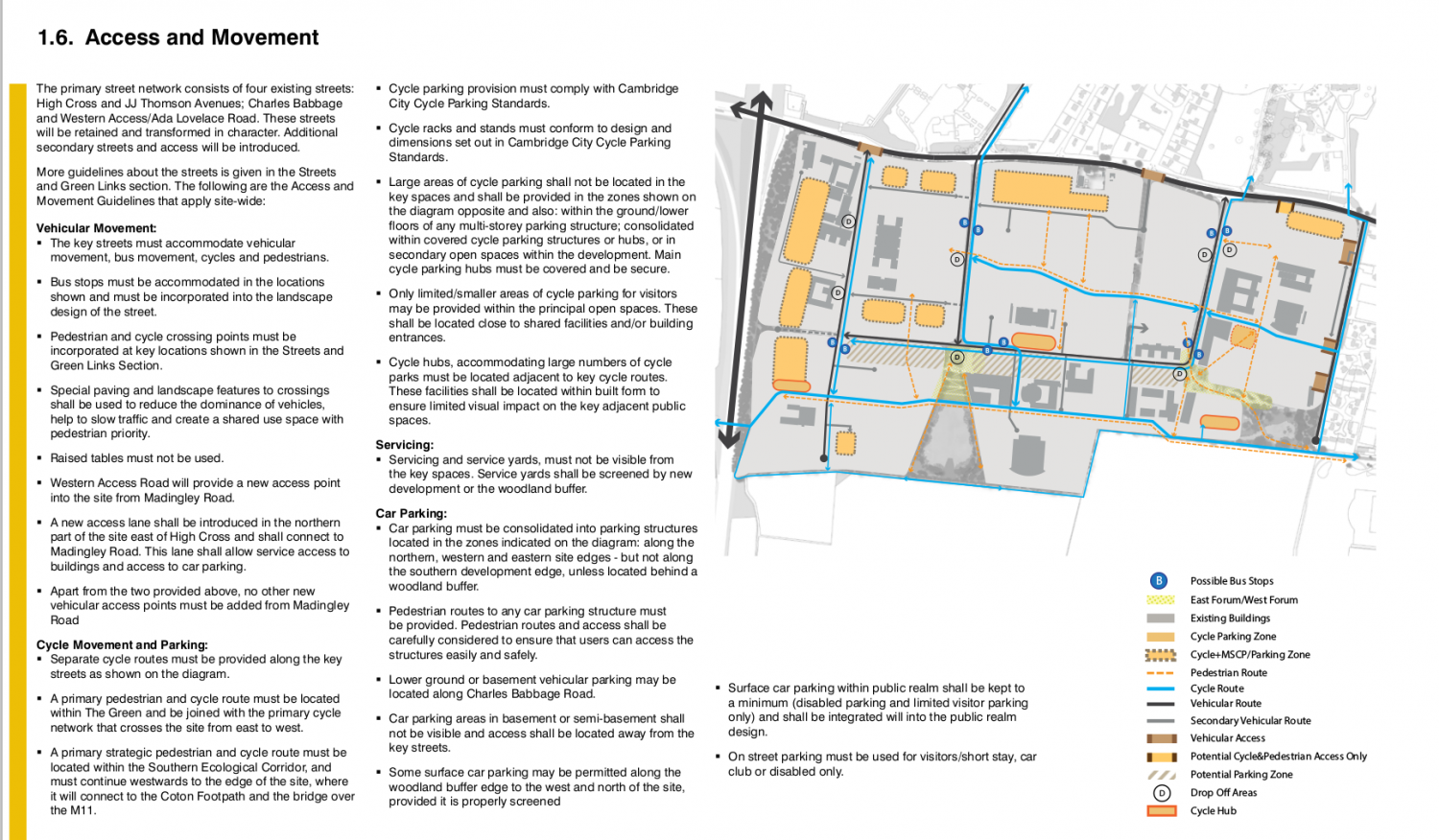West Cambridge: Difference between revisions
From West Cambridge Active Travel (WCAT)
Jump to navigationJump to search
(→Transport Assessment: adams road) |
|||
| Line 32: | Line 32: | ||
** as suggested by the Cambridge Cycle Campaign, maintenance to the existing vegetation that currently reduces the effective width of this route constraining forward visibility; | ** as suggested by the Cambridge Cycle Campaign, maintenance to the existing vegetation that currently reduces the effective width of this route constraining forward visibility; | ||
** the route would be realigned where possible to remove the sharp turns along [[Coton Path]] directly to the south of West Cambridge; and the eastern terminus of the [[Coton Path]] – the junction with Wilberforce Road and [[Adams Road]] – will be redesigned providing a more direct and continuous route for Cyclists while also slowing passing vehicles – thus prioritising Cycle movements. Details are shown on Figure 6.16. | ** the route would be realigned where possible to remove the sharp turns along [[Coton Path]] directly to the south of West Cambridge; and the eastern terminus of the [[Coton Path]] – the junction with Wilberforce Road and [[Adams Road]] – will be redesigned providing a more direct and continuous route for Cyclists while also slowing passing vehicles – thus prioritising Cycle movements. Details are shown on Figure 6.16. | ||
* 6.9.8 As shown on Figure 6.15, it is proposed that a Cycle Street environment could be created along [[Adams Road]]. As part of this, the University will contribute to the necessary traffic regulation orders to rationalise parking to provide more road space for Cycling. | |||
Revision as of 13:19, 14 February 2017
Planning Documents
- 16/1134/OUT Official website showing outline planning permission for new developments at West Cambridge Site.
- Upcoming pre-application meeting: Thursday 16th Feb, 3:30pm at the Council Chamber of the Guild Hall, Market Square.
Design Guidelines
Planned access and movement map:
JJ Thomson Ave redesign conceptual view: See also: Cross-section of High Cross showing pavements, cycle lanes, trees and carriageway.
- Part 3: File:16 1134 OUT-DESIGN GUIDELINES PART3-1963107.pdf
- Part 4: File:16 1134 OUT-DESIGN GUIDELINES PART4-1963109.pdf
Transport Assessment
- Part 1: File:16 1134 OUT-TRANSPORT ASSESSMENT PART1-2090515.pdf (main document)
Access and movement strategy (starting on pg 50). Selected quotes:
- 6.5.13 To maintain their attractiveness, the proposed with-flow segregated Cycle tracks along the main routes through West Cambridge must be continuous and as such retain priority over side road junctions and vehicular accesses to plots. To achieve this, the priority along the Cycle track would be clearly identified when crossing the side road - this would also serve to slow on-site vehicle speeds.
- 6.5.15 The strategy outlined above provides only a limited number of routes that require cyclists to be on-road: these are confined to quiet none-through routes.
- 6.5.16 The ‘with-traffic’ provision on the main routes will have a segregated provision either adjacent to the road (e.g. the Western Access Road) or adjacent to the footway (e.g. Charles Babbage Road, High Cross, JJ Thomson Avenue).
- 6.5.17 As new on-site infrastructure is delivered, cyclists would be provided with continuous routes, with priority over side road movements.
- 6.8.12 As discussed and agreed with the Joint Authorities, the University would contribute towards the costs of this existing on-road car parking being removed from both sides of the carriageway, and being replaced with two mandatory cycle lanes. This would provide significant betterment for residents and cyclists, and improve the quality of the public realm on [Clerk Maxwell Road].
- 6.9.5 To enhance Walking and Cycling, the University would make contributions towards the delivery of the following improvements to the existing Coton Path route, reflecting the concerns of the West and North West Cambridge Cycling Group, and the Cambridge Cycling Campaign:
- as shown on Figure 6.1, at the western end of West Cambridge, a new Cycle and Pedestrian route will be provided between the M11 bridge crossing and the Western Access Road within West Cambridge. This will reduce the distance between these two points by approximately 250 metres, providing better access to locations within West Cambridge;
- the Coton Path will be widened within the boundary of the West Cambridge site, where achievable, to improve connections to the east;
- improved connections to Coton Path will be redesigned to improve the layout for pedestrians and cyclists accessing West Cambridge. The key connections to be improved include those at the end of Clark Maxwell Road), the Cavendish Laboratory areas and that to the east of the Hauser Forum Building. The Cavendish Laboratory access would provide a new access to Coton Path that gives cyclists an alternative route between the existing Hauser Forum and Broers Building which can then become pedestrian only;
- as suggested by the Cambridge Cycle Campaign, maintenance to the existing vegetation that currently reduces the effective width of this route constraining forward visibility;
- the route would be realigned where possible to remove the sharp turns along Coton Path directly to the south of West Cambridge; and the eastern terminus of the Coton Path – the junction with Wilberforce Road and Adams Road – will be redesigned providing a more direct and continuous route for Cyclists while also slowing passing vehicles – thus prioritising Cycle movements. Details are shown on Figure 6.16.
- 6.9.8 As shown on Figure 6.15, it is proposed that a Cycle Street environment could be created along Adams Road. As part of this, the University will contribute to the necessary traffic regulation orders to rationalise parking to provide more road space for Cycling.

